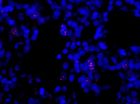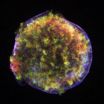(Press-News.org) Scientists at Johns Hopkins have provided more clues to one of the least understood phenomena in some cancers: why the "ends caps" of cellular DNA, called telomeres, lengthen instead of shorten.
In a study published online June 30 in Science Express, the Johns Hopkins researchers say they have identified two genes that, when defective, may cause these telomere elongations.
Telomeres contain repeated sequences of DNA that, in normal cells, shorten each time a cell divides. Without telomeres, the cell division-related shortening could snip off a cell's genes and disrupt key cell functions. Most cancer cells, naturally prone to divide rapidly, use high amounts of an enzyme called telomerase to keep their telomeres intact. Yet, some cancer cells are known to maintain their telomere length without help from telomerase.
With no increased production of telomerase, scientists were left to wonder how cancer cells managed to maintain their telomeres, a phenomenon known as "alternative lengthening of telomeres."
"Finding the genes responsible for alternative lengthening of telomeres is the first step in understanding this process and provides opportunities to develop new drug therapies," says Nickolas Papadopoulos, Ph.D., associate professor at the Johns Hopkins Kimmel Cancer Center and director of translational genetics at Johns Hopkins' Ludwig Center.
The first clues to the genes linked to the process came from a study led by Papadopoulos that mapped the genome of pancreatic neuroendocrine tumors, published in the Jan. 20 issue of Science Express. The most prevalent gene alterations in those tumors occurred in genes that include ATRX and DAXX. Proteins made by these genes interact with specific portions of DNA to alter how its chemical letters are read. ATRX and DAXX had also been linked to similar functions in the telomere region, says Alan Meeker, Ph.D., assistant professor of pathology, urology and oncology at Johns Hopkins.
Following a hunch, Meeker and his colleagues took a closer look at the two genes and their specific role in telomere lengthening. With tissue samples from 41 patients with pancreatic neuroendocrine tumors collected during the genome mapping project, the scientists found characteristic signatures of alternative telomere lengthening in 25 of them. Fluorescent dyes targeted specifically to telomeres showed "huge aggregates of telomere DNA" in the 25 samples, with each fluorescent spot holding about 100 times more telomere DNA than normal cells, according to Meeker.
Nineteen of the 25 samples that glowed positive for alternative telomere lengthening had either ATRX or DAXX mutations. Six of those
25 samples did not contain ATRX or DAXX mutations, but the tumor cells showed no expression of these two genes. The remaining 16 samples with no alternative lengthening lacked mutations and had adequate ATRX and DAXX expression.
"We saw a 100 percent correlation between abnormalities in ATRX and DAXX and alternative lengthening of telomeres," says Meeker.
Among 439 other samples of tumors tested by Meeker, Papadopoulos and colleagues, ATRX mutations were found in several brain cancer types, including pediatric and adult glioblastoma samples provided by Hai Yan, M.D., Ph.D., and Darell Bigner, M.D., Ph.D., of Duke University.
Meeker and colleagues tested the telomeres status in glioblastoma samples with tissue available for the assay. All eight glioblastoma tissue samples with ATRX mutations showed the characteristic bright glow of their telomeres, indicative of alternative lengthening, and lack of ATRX expression.
Although the Johns Hopkins team does not yet have an explanation for how the genes do their lengthening work in cancer, Meeker speculates that the mutations alter the way that telomere DNA is packaged, exposing those areas to instability.
Papadopoulos' genome mapping studies showed that patients with pancreatic neuroendocrine tumors containing ATRX/DAXX mutations had better survival than those without the mutations.
"If the correlation holds up, we could use alternative lengthening of telomeres and ATRX/DAXX mutations as a method of determining a patient's prognosis in addition to developing treatments that target these genes," says Meeker.
INFORMATION:
Funding for the study was provided by the Caring for Carcinoid Foundation, a nonprofit foundation that funds research on carcinoid cancer, pancreatic neuroendocrine cancer, and related neuroendocrine cancers, the Lustgarten Foundation for Pancreatic Cancer Research, the Virginia and D.K. Ludwig Fund for Cancer, National Institutes of Health, the Sol Goldman Pancreatic Cancer Research Center, the American Cancer Society, the Pediatric Brain Tumor Foundation Institute, the Duke Comprehensive Cancer Center Core, the Fundacao de Amparo a Pesquisa do Estado de Sao Paulo, and the Department of Defense Breast Cancer Research Program.
Co-authors of the research include Christopher M Heaphy, Roeland F de Wilde, Yuchen Jiao, Alison P Klein, Barish H Edil, Kenneth W Kinzler, Bert Vogelstein, Ralph H Hruban, Anirban Maitra, Chetan Bettegowda, Fausto J Rodriguez, Charles G Eberhart, and Sachidanand Hebbar from Johns Hopkins; Chanjuan Shi from Vanderbilt University; Johan A Offerhaus from the University Medical Center Utrecht, the Netherlands; Roger McLendon, B. Ahmed Rasheed, Yiping He, Hai Yan, and Darell D. Bigner from Duke University; and Sueli Mieko Oba-Shinjo and Suely Kazue Nagahashi Marie from the University of Sao Paulo, Brazil.
Photo of fluorescent telomeres in pancreatic neuroendocrine tumor cells available upon request.
Telomeres: 2 genes linked to why they stretch in cancer cells
2011-07-01
ELSE PRESS RELEASES FROM THIS DATE:
Your Nose: Form and Function
2011-07-01
Your nose does more than just sit in the middle of your face and present a good metaphor for everything obvious. Your nose is essential to breathing, smelling, and protecting your body from dehydration and infection.
Nasal Breathing
Nasal breathing should be the normal method. Mouth breathing is reserved for when you're running for your life or trying to make a creepy phone call. Nasal breathing performs a number of important functions:
- Conditioning the air: Your nose warms incoming air and adds humidity to protect your throat and lungs
- Filtering the air: ...
The Role of a Plastic Surgeon in Your Mastectomy
2011-07-01
Adjusting to the loss of a breast or to a different breast shape following a mastectomy can be traumatic. A mastectomy may save your life, but it can also leave you feeling self-conscious about your appearance.
In considering a mastectomy, one important decision is whether you will want to undergo breast reconstruction at the time of your mastectomy. A consultation with a breast reconstruction surgeon prior to scheduling your mastectomy can help you determine whether you're a good candidate for breast reconstruction surgery and review your breast reconstruction options.
Mastectomy ...
'Zombie' stars key to measuring dark energy
2011-07-01
(Santa Barbara, Calif.) –– "Zombie" stars that explode like bombs as they die, only to revive by sucking matter out of other stars. According to an astrophysicist at UC Santa Barbara, this isn't the plot for the latest 3D blockbuster movie. Instead, it's something that happens every day in the universe –– something that can be used to measure dark energy.
This special category of stars, known as Type Ia supernovae, help to probe the mystery of dark energy, which scientists believe is related to the expansion of the universe.
Andy Howell, adjunct professor of physics ...
Breast Lift Incision Options
2011-07-01
There are several different incision patterns and techniques used in New York City breast lift surgeries. Some of these techniques have been used for years, while other incision procedures are relatively new.
If you are thinking about having breast lift surgery, be sure to first educate your self on all the available incision options. Then speak to a New York City breast lift surgeon about your options, and which incision would best meet your needs. Some of the most common incision types are described below.
The Anchor Incision
An anchor incision is made around ...
Why do we share stories, news and information with others?
2011-07-01
People often share stories, news, and information with the people around them. We forward online articles to our friends, share stories with our co-workers at the water cooler, and pass along rumors to our neighbors. Such social transmission has been going on for thousands of years, and the advent of social technologies like texting, Facebook, and other social media sites has only made it faster and easier to share content with others. But why is certain content shared more than others and what drives people to share?
Well, according to Jonah Berger, the author of a new ...
Red wine: Exercise in a bottle?
2011-07-01
Bethesda, MD—As strange as it sounds, a new research study published in the FASEB Journal (http://www.fasebj.org), suggests that the "healthy" ingredient in red wine, resveratrol, may prevent the negative effects that spaceflight and sedentary lifestyles have on people. The report describes experiments in rats that simulated the weightlessness of spaceflight, during which the group fed resveratrol did not develop insulin resistance or a loss of bone mineral density, as did those who were not fed resveratrol.
According to Gerald Weissmann, M.D., Editor-in-Chief of the ...
Fireworks Safety Tips: Don't Blow Off Your Hand - 10 Ways to Stay Safe With Fireworks
2011-07-01
With July 4 fast approaching, MSNBC reports that heavy drought and wildfires burning in parts of Florida have caused many affected counties and cities to ban the use of fireworks.
Florida Division of Forestry Annaleasa Winter says, "It only takes one spark to ignite a blazing wildfire that could threaten your home and, possibly, your whole neighborhood. The risk is just too great," as News 4 Jax reports regarding similar drought and wildfires last year in Florida.
2011 is no different.
But, like every July 4 holiday, you're going to get together with ...
CSHL team identifies enzyme that is an important regulator of aggressive breast cancer development
2011-07-01
Cold Spring Harbor, NY – Researchers at Cold Spring Harbor Laboratory (CSHL) have identified an enzyme that appears to be a significant regulator of breast cancer development. Called PTPN23, the enzyme is a member of a family called protein tyrosine phosphatases, or PTPs, that plays a fundamental role in switching cell signaling on and off.
When the scientists suppressed the expression of PTPN23 in human mammary cells, they noted a cascade of effects that included the cells breaking away from their anchors; their scattering; and their invasion through extracellular ...
NIH funds massive genome studies that identify genetics behind white blood cell counts
2011-07-01
WHAT: A trio of large-scale genome-wide association studies, or GWAS, have identified more than 15 gene variants responsible for the diversity of white blood cell counts among whites, African-Americans, and Japanese. Supported in part by the National Institutes of Health, each study examined the genomes of tens of thousands of people. Combined, the studies offer the first comprehensive analysis into why some people, and some populations, have more or fewer white blood cells than others.
All three articles will be published online June 30 in PLoS Genetics.
White ...
Heart transplant patients at risk for serious skin cancers
2011-07-01
A new study published in the American Journal of Transplantation reveals that there is a significant risk of serious skin cancers, including cutaneous squamous cell carcinoma and melanoma, in heart transplant patients.
When people receive heart transplants, they need immune medications to keep their body from rejecting the transplant. The changes to the immune system they experience as a result of the medications can also make them more susceptible to developing cancers.
Led by Murad Alam, MD, MSCI, of Northwestern University, researchers studied 10 years of patient information ...

